
Interesting Facts For Curious Minds: 1572 Random But Mind-Blowing Facts About History, Science, Pop Culture And Everything In Between
You Can Count On It
byYou can count on it: numbers and mathematical principles have a fascinating way of showing up in many aspects of life, from prime numbers to geometry and probability. One of the most mind-boggling concepts in math is the largest known prime number, which contains a staggering 24,862,048 digits when written in base 10. Discovered in 2018 by Patrick Laroche, this prime number serves as a reminder of the infinite possibilities within mathematics. But prime numbers are only one example of the complexity of numbers. Another key concept is the development of zero, which seems so simple today, yet was a monumental advancement for ancient mathematicians, particularly in India, where it was first used in written form as early as the 7th century CE. The absence of zero in early systems of counting makes its inclusion a significant milestone in mathematical history.
Mathematics continues to evolve and play a vital role in understanding the world. Geometry, for instance, deals with shapes that are formed by a finite number of straight lines, known as polygons. Triangles and squares are basic examples of polygons, while circles, despite their round shape, do not qualify because they lack straight lines. This illustrates the precision required in geometric classifications. Similarly, some mathematical rules are more quirky than others, like the pattern found when multiplying the number nine by any other number. If you add up the digits of the resulting sum, they will always equal nine. For example, 127 multiplied by 9 gives 1,143, and if you add 1+1+4+3, you again get 9. This fun numerical trick illustrates how patterns in mathematics can sometimes be deceptively simple yet universally true.
Mathematics doesn’t just apply to abstract concepts; it’s also used extensively in practical fields such as economics, engineering, and even finance. The discipline of combinatorics, for example, involves the study of counting and arranging objects, and it forms the basis for probability theory and even finite geometry. These mathematical tools allow scientists, economists, and engineers to make predictions, analyze systems, and design solutions to complex problems. Game theory, a field that combines math with social science and logic, helps individuals and organizations make decisions based on potential outcomes. This is especially relevant in economic and political scenarios, where calculating gains and losses is crucial. Similarly, “quants,” or quantitative analysts, use complex mathematical methods to guide investment strategies in finance, employing techniques such as quantitative investment management to assess market trends and make informed decisions.
Mathematics has also shaped our understanding of ancient cultures and their practices. The ancient Greek mathematician Pythagoras, known for his famous theorem (a² + b² = c²), was not only an intellectual but also a mystic who led a commune. His work in geometry had a profound influence on later mathematical developments, showing that numbers are deeply intertwined with the natural world. This connection between math and mysticism is evident throughout history, even in the way we measure time. For example, the term “jiffy,” often used to describe a short amount of time, refers to 1/100th of a second in computer animation or the duration of an alternating current power cycle in electronics. This illustrates the variety of ways that mathematical units, whether large or small, affect our understanding of time and technology.
The concept of mathematical precision also extends to practical applications, such as accounting and engineering. The double-entry system of bookkeeping, attributed to Florentine merchant Amatino Manucci, has been used since the late 13th century. His accounting methods, which were ahead of their time, laid the foundation for modern financial record-keeping. Similarly, in mechanical and electrical engineering, complex analysis is used to calculate variables such as the forces acting on a satellite during launch. This type of math helps engineers design and maintain systems that require precise calculations to function properly, from electrical grids to space missions. Mathematics, therefore, is not just a theoretical pursuit but a tool for solving real-world problems that require accuracy and efficiency.
Fun and seemingly trivial mathematical principles, like the Ham Sandwich Theorem, add another layer to the importance of math in everyday life. This theorem suggests that it is always possible to divide a ham and cheese sandwich into two equal parts by a single straight cut, which is a simple yet intriguing example of geometric principles at work. Similarly, the fact that a standard deck of 52 playing cards has 52! (52 factorial) possible arrangements demonstrates the vast number of combinations that can arise from something as simple as a deck of cards. The sheer number of possible permutations underscores how even basic objects can be subject to complex mathematical calculations. Whether in games, economics, or technology, mathematics is integral to making sense of the world around us, highlighting its relevance and impact on our daily lives.

